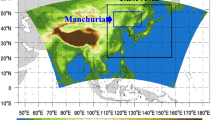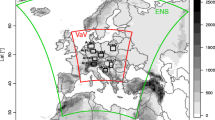Abstract
The European Centre for Medium-Range Weather Forecasts Reanalysis ERA40, National Centers for Environmental Prediction (NCEP) 20th-century reanalysis, and three station observations along an Antarctic traverse from Zhongshan to Dome-A stations are used to assess 2-m temperature simulation skill of a regional climate model. This model (HIRHAM) is from the Alfred Wegener Institute for Polar and Marine Research in Germany. Results show: (1) The simulated multiyear averaged 2-m temperature field pattern is close to that of ERA40 and NCEP; (2) the cold bias relative to ERA40 over all of Antarctic regions is 1.8°C, and that to NCEP reaches 5.1°C; (3) bias of HIRHAM relative to ERA40 has seasonal variation, with a cold bias mainly in the summer, as much as 3.4°C. There is a small inland warm bias in autumn of 0.3°C. Further analysis reveals that the reason for the cold bias of 2-m temperature is that physical conditions of the near-surface boundary layer simulated by HIRHAM are different from observations: (1) During the summer, observations show that near-surface atmospheric stability conditions have both inversions and non-inversions, which is due to the existence of both positive and negative sensible heat fluxes, but HIRHAM almost always simulates a situation of inversion and negative sensible heat flux; (2) during autumn and winter, observed near-surface stability is almost always that of inversions, consistent with HIRHAM simulations. This partially explains the small bias during autumn and winter.
Similar content being viewed by others
References
Allison I, Morrissy J V. 1983. Automatic weather stations in the Antarctic. Aust Meteor Mag, 31: 71–76
Bailey D A, Lynch A H. 2000a. Development of an Antarctic regional climate system model. Part I: Sea ice and large-scale circulation. J Clim, 13: 1337–1350
Bailey D A, Lynch A H. 2000b. Development of an Antarctic regional climate system model. Part II: Station validation and surface energy balance. J Clim, 13: 1351–1361
Bromwich D H, Monaghan A J, Manning K W, et al. 2005. Real-time forecasting for the Antarctic: An evaluation of the Antarctic Mesoscale Predition System (AMIPS). Mon Weather Rev, 133: 579–603
Chen B L, Zhang R H, Sun S F, et al. 2010a. A one-dimensional heat transfer model on Antarctic Ice Sheet and modeling of near-surface temperatures at Dome A, the summit of Antarctic Plateau. Sci China Earth Sci, 53: 763–772
Chen B L, Zhang R H, Xiao C D, et al. 2010b. Analysis on the air and snow temperatures near ground with observations of an AWS at Dome A, the summit of Antarctic Plateau. Chin Sci Bull, 55: 1430–1436
Christensen J H, Hewitson B, Busuioc A, et al. 2007. Regional climate projections. In: Solomon S, Qin D, Manning M, et al., eds. Climate Change 2007: The Physical Science Basis. Cambridge: Cambridge University Press. 847–940
Christensen J H, Christensen O B, Lopez P. 2006. The HIRHAM4 Regional Atmospheric Climate Model. Technical Report. DMI Sci Rep, 96-4, Dan Meteorol Inst, Copenhagen, Denmark
Connolley W M, Cattle H. 1994. The Antarctic climate of the UNKO unified model. Antarct Sci, 6: 115–122
Fouquart Y, Bonnel B. 1980. Computation of solar heating of the Earth’s atmosphere: A new parameterization. Beitr Phys Atmos, 53: 35–62
Fraedrich K, Leslie L. 1991. Predictability studies of the Antarctic atmosphere. Aust Meteor Mag, 39: 1–9
Gao X J, Xu Y, Zhao Z C, et al. 2006. On the role of resolution and topography in the simulation of East Asia precipitation. Theor Appl Climatol, 86: 173–184
Gao X J, Shi Y, Giorgi F. 2011. A high resolution simulation of climate change over China. Sci China Earth Sci, 53: 462–472
Giorgi F, Mearns L O. 1991. Approaches to regional climate change simulations: a review. Rev Geophys, 29: 191–216
Glushak K. 2008. Atmospheric circulation and the surface mass balance in a regional climate model of Antarctic. Doctoral Dissertation, Germany: University of Potsdam. 143
Grachev A A, Andreas E L, Fairall C W, et al. 2007. SHEBA flux-profile relationships in the stable atmospheric boundary layer. Bound-Layer Meteor, 124: 315–333
Holtslag A A M, Bruin H A R. 1988. Applied modeling of the nighttime surface energy balance over land. J Appl Meteorol, 27: 689–704
Louis J F. 1979. A parameteric model of vertical eddy fluxes in the atmosphere. Bound-Layer Meteor, 17: 187–202
Ma Y F. 2009. Characteristic parameters of near surface layer of the traverse route from Zhongshan Station to Dome-A, East Antarctica (in Chinese). Master Thesis. Beijing: Chinese Academy of Meteorological Sciences
Meehl G A, Stocker T F, Collins W D, et al. 2007. Global climate projections. In: Solomon S, Qin D, Manning M, et al., eds. Climate Change 2007: The Physical Science Basis. Cambridge: Cambridge University Press. 747–846
Powers J G, Monaghan A J, Cayette A M, et al. 2003. Real-time mesoscale modeling over Antarctica: The Antarctic Mesoscale Prediction System (AMPS). Bull Amer Meteor Soc, 84: 1533–1544
Qu X, Hall A. 2005. Surface contribution to planetary albedo variability in cryosphere regions. J Clim, 18: 5239–5252
Reijmer C H, E van Meijgaard, van den Broeke M R. 2005. Evaluation of temperature and wind over Antarctica in a Regional Atmospheric Climate Model using 1 year of automatic weather station data and upper air observations. J Geophys Res, 110: D04103, doi: 10.1029/2004JD005234
Roeckner E, Bäuml G, Bonaventura L, et al. 2003. The Atmospheric General Circulation Model ECHAM5. Part 1. Model description. Technical Report. Report No.349, Max-Planck-Institut für Meteorologie (MPI-M)
Tiedtke M. 1989. A comprehensive mass flux scheme for cumulus parameterization in large-scale models. Mon Wea Rev, 117: 1779–1800
Undén P, Rontu L, Järvinen H, et al. 2002. HIRLAM-5 Scientific Documentation. Technical Report. European Meteorological Institutes
Wild M, Calanca P, Scherrer S C, et al. 2003. Effects of polar ice sheets on global sea level in high-resolution greenhouse scenarios. J Geophys Res, 108: 1–10
Xin Y, Rinke A, Bian L, et al. 2010. Climate and forecast mode simulations for Antarctica: Implications for temperature and wind. Adv Atmos Sci, 27: 1453–1472
Author information
Authors and Affiliations
Corresponding author
Rights and permissions
About this article
Cite this article
Xin, Y., Bian, L., Rinke, A. et al. Simulation and evaluation of 2-m temperature over Antarctica in polar regional climate model. Sci. China Earth Sci. 57, 703–709 (2014). https://doi.org/10.1007/s11430-013-4709-z
Received:
Accepted:
Published:
Issue Date:
DOI: https://doi.org/10.1007/s11430-013-4709-z




